Online Gather.town Pitches
Miscellaneous Clinical Body MRI
Joint Annual Meeting ISMRM-ESMRMB & ISMRT 31st Annual Meeting • 07-12 May 2022 • London, UK

| Booth # | ||||
|---|---|---|---|---|
4476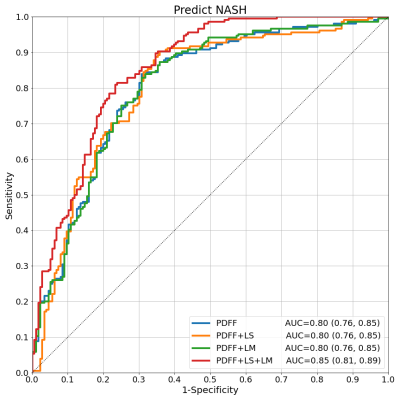 |
1 | Diagnostic Performance of PDFF and Multi-Frequency 3D-MRE in the Detection of NASH and NASH-Required Therapy in a Large Cohort of 380 Patients
Kyle Kalutkiewicz1, Jiahui Li1, Zheng Zhu1, Jun Chen1, Taofic Mounajjed2, Kevin J. Glaser1, Safa Hoodeshenas1, Sudhakar K. Venkatesh1, Armando Manduca1, Claude B. Sirlin3, Vijay H. Shah4, Alina M. Allen4, Richard L. Ehman1,
and Meng Yin1
1Radiology, Mayo Clinic, Rochester, MN, United States, 2Surgical Pathology, Mayo Clinic, Rochester, MN, United States, 3Radiology, UC San Diego, La Jolla, CA, United States, 4Gastroenterology and Hepatology, Mayo Clinic, Rochester, MN, United States
Liver biopsy and multi-parametric MRI/MRE were performed on 380 patients at risk of NASH. Histopathological diagnoses of NASH were collected along with proton density fat fraction (PDFF), and 3D-MRE measured liver stiffness (LS) and loss modulus (LM). While PDFF alone showed good ability to predict NASH (AUC: 0.80 [0.76, 0.85]), the addition of MRE measurements increased the diagnostic performance with strong statistical significance (AUC: 0.85 [0.81, 0.89], p<0.0004). LS alone was also found to be the strongest predictor of NASH-required treatment (AUC: 0.89 [0.84, 0.93], p<0.05), further establishing the critical role of MRE for clinical management of liver disease.
|
||
4477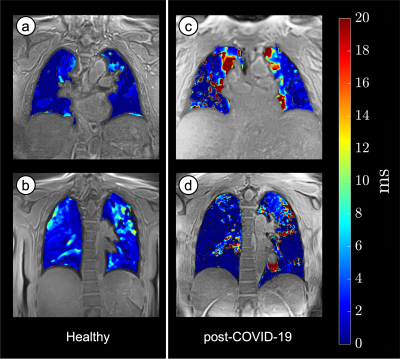 |
2 | Pulmonary Vasculature and T2* mapping of Lung in post-COVID subjects using Free-Breathing 3D UTE
Vadim Malis1, Won Bae1, Jirach Kungsamutr2, Xiaowei Zhang1, Yoshimori Kassai3, Andrew Yen1, Susan Hopkins1, Yoshiharu Ohno4, and Mitsue Miyazaki1
1Radiology, UC San Diego, San Diego, CA, United States, 2Bioengineering, UC San Diego, San Diego, CA, United States, 3Canon Medical Systems Corp., Tochigi, Japan, 4Radiology, Fujita Health University, Toyoake, Japan
Free-breathing 3D MRI techniques are applied to explore the impact of COVID-19 in adults. Single echo non-fat suppressed Ultra-short TE (UTE) was utilized for automatic segmentation of lung, Multi-echo UTE with fat suppression was used to obtain T2* maps, and UTE with Time-Spatial Labeling Inversion Pulse (Time-SLIP) allowed to visualize pulmonary vasculature.
|
||
4478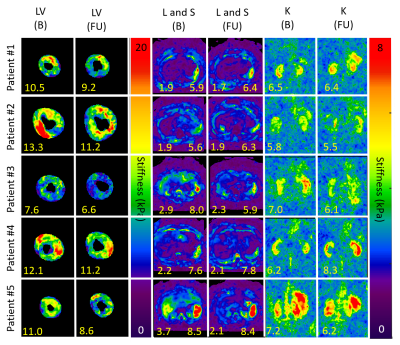 |
3 | Monitoring Multi-Organ Stiffness Changes with MR Elastography in Amyloidosis Patients Treated with Stem Cell Therapy
Arvin Arani1, Jessica Magnuson1, Zheng Zhu1, Joshua D. Trzasko1, Yi Sui1, Devanshi Damani1, Kevin Glaser1, Matthew C. Murphy1, Meng Yin1, Angela Dispenzieri1, Richard L. Ehman1, Sudhakar K. Venkatesh1, and Philip A. Araoz1
1Mayo Clinic, Rochester, MN, United States
Light chain (AL) cardiac amyloidosis is a disease where abnormal proteins are deposited in multiple organs and is associated with elevated tissue stiffness. In cases with poor prognosis, autologous hematopoietic stem cell transplantation (ASCT) is used for therapy. Organ response monitoring is currently limited and challenging. The objective of this study was to evaluate the feasibility of using magnetic resonance elastography (MRE) to monitor stiffness changes in multiple organs pre- and post- ASCT therapy. At 3 months post therapy, significant reduction in MRE stiffness (p<0.001) was observed in organs that exhibited successful therapy response (defined by 9 month clinical outcomes).
|
||
4479 |
4 | High-resolution, high-contrast MRI protocol with extended delayed imaging for peritoneal mesothelioma
Milica Medved1, Hunter D. D Witmer2, Ankit D. D Dhiman2, Yaniv Berger3, Scott K Sherman4, Enal S Hindi2, Samuel G Armato III1, Ingrid S Reiser1, Aytekin Oto1, Roger M Engelmann1, Hedy L Kindler5, Nisa C Oren1, Carla B Harmath1,
and Kiran K Turaga2
1Department of Radiology, The University of Chicago, Chicago, IL, United States, 2Department of Surgery, The University of Chicago, Chicago, IL, United States, 3Department of Surgery B, Chaim Sheba Medical Center, Ramat Gan, Israel, 4Department of Surgery, University of Iowa, Iowa City, IA, United States, 5Department of Medicine, The University of Chicago, Chicago, IL, United States
Improved methods for visualizing malignant peritoneal mesothelioma are needed. A high-resolution, high-contrast MRI protocol at 3T, including multiple delayed phases, was tested in 18 patients scheduled for laparoscopy/laparotomy. Both contrast washout and ongoing uptake was observed in individual lesions, pointing to a need for imaging with both short and long post-contrast delay times for optimal sensitivity. The per-patient average uptake/washout rate was significantly correlated with the cumulative nuclear score on pathology. The tested MRI protocol is feasible and may allow for more accurate visualization of peritoneal lesions and better guidance of management options.
|
||
4480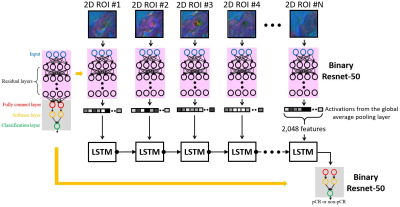 |
5 | Predicting breast cancer treatment response using a hybrid deep learning network on multislice SyntheticMR images
Jong Bum Son1, Ken-Pin Hwang1, David E Rauch1, Ju Hee Ahn2, Jiyoung Lee3, Zijian Zhou1, Bikash Panthi4, Beatriz Adrada4, Rosalind P Candelaria4, Jason B White5, Mary Guirguis4, Rania M Mohamed6, Elizabeth E Ravenberg7,
Clinton Yam7, Debasish Tripathy7, and Jingfei Ma1
1Department of Imaging Physics, The University of Texas MD Anderson Cancer Center, Houston, TX, United States, 2Radiology Department, GangNam Radiology Clinic, Busan, Korea, Republic of, 3College of Medicine, Chung-Ang University, Seongnam-si, Korea, Republic of, 4Department of Breast Imaging, The University of Texas MD Anderson Cancer Center, Houston, TX, United States, 5Department of Moon Shots Operations, The University of Texas MD Anderson Cancer Center, Houston, TX, United States, 6Department of Breast Imaging Research, The University of Texas MD Anderson Cancer Center, Houston, TX, United States, 7Department of Breast Medical Oncology, The University of Texas MD Anderson Cancer Center, Houston, TX, United States
We developed a hybrid deep learning network combining convolutional neural (CNN) and long short-term memory (LTSM) networks to predict slice-to-slice consistent responses to neoadjuvant systematic therapy (NAST) in triple negative breast cancer (TNBC) patients using multislice quantitative SyntheticMR images. We demonstrated that neural networks originally developed for video feature classification can be adapted to predict treatment response of cancer patients using MR images. Our hybrid network was able to overcome the slice-to-slice inconsistency that would have resulted if a 2D network is applied directly, therefore providing higher prediction accuracy.
|
||
4481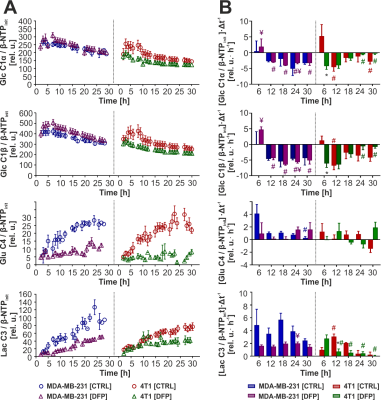 |
6 | Intracellular Iron Chelation affects Cellular Metabolism in Triple Negative Breast Cancer Cells: Comparison between Human and Murine Models Video Permission Withheld
Paola Porcari1, Ellen Ackerstaff1, Soe Su Min1, Dov P. Winkleman1, H. Carl Lekaye1, and Jason A. Koutcher2,3,4,5
1Medical Physics, Memorial Sloan-Kettering Cancer Center, New York, NY, United States, 2Medical Physics, Memorial Sloan Kettering Cancer Center, New York, NY, United States, 3Department of Medicine, Memorial Sloan Kettering Cancer Center, New York, NY, United States, 4Molecular Pharmacology Program, Memorial Sloan Kettering Cancer Center, New York, NY, United States, 5Weill Cornell Medical College, Cornell University, New York, NY, United States
We investigated the effect of Deferiprone, an iron chelator clinically used for non-cancer related diseases, on cellular metabolism and the impairment of cell growth in the human MDA-MB-231 and murine 4T1 triple-negative breast cancer models. By comparing the findings obtained on both cell lines through 13C MRS monitoring with those related to mitochondrial respiration, we aimed to better understand the metabolic mechanism driving the changes that follow Deferiprone exposure. A stronger effect of DFP exposure was observed in human MDA-MB-231 cells than murine 4T1 cells.
|
||
4482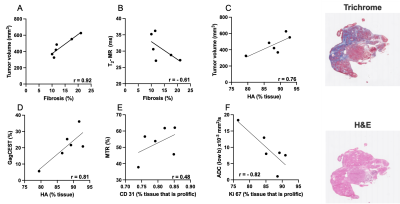 |
7 | MR imaging of increased fibrotic tissue and hyaluronan deposition in the advanced stages of pancreatic ductal adenocarcinoma
Ravneet Vohra1, Yak-Nam Wang2, Helena Son3, Stephanie Totten2, Akshit Arora4, Adam Maxwell5, and Donghoon Lee1
1Radiology, University of Washington, Seattle, WA, United States, 2Applied Physics Laboratory, University of Washington, Seattle, WA, United States, 3Gastroenterology, University of Washington, Seattle, WA, United States, 4Arts and Sciences, University of Washington, Seattle, WA, United States, 5Urology, University of Washington, Seattle, WA, United States
Pancreatic cancer is expected to become the second leading cause of the cancer-related deaths in the USA by 2030. A genetically engineered mouse model (KPC) offers an alternative to transplantation models for preclinical therapeutic evaluation as it expresses mutations similar to human pancreatic cells. MRI can be used to monitor the tumor microenvironment in a variety of tumors. The goal of this study was to monitor fibrotic tissue and hyaluronan deposition in the KPC mouse model during the late stages of tumor development.
|
||
The International Society for Magnetic Resonance in Medicine is accredited by the Accreditation Council for Continuing Medical Education to provide continuing medical education for physicians.